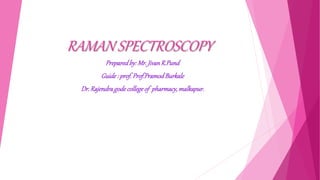
Raman Spectroscopy Technique
- 1. RAMAN SPECTROSCOPY Preparedby:Mr.JivanR.Pund Guide: prof.Prof.PramodBurkale Dr.Rajendragodecollegeof pharmacy,malkapur.
- 2. Sir Chandrasekhara Venkata Raman • November 7, 1888 - November 21, 1970 • Won the Nobel prize in 1930 for Physics • Discovered the “Raman effect” • Besides discovering the Raman effect he • studied extensively in X-ray Diffractions. • phenomenon
- 3. CONTENT……… INTRODUCTION PRINCIPLE QUANTUM MECHANISM OF R.S. INSTRUMENTATION DIFFERENCE ADVANTAGES/DISADVANTAGES APPLICATION
- 4. Introduction Raman spectroscopy deals with the scattering of light and not with its absorption,homonuclear diatomic molecules such as H2 ,O2,N2 Etc. Which do not show I.R. spectra since they do not posses a permanent dipole movement do show raman spectra since there vibration is accompanied by change polarizability of the molecules. It gives imformation about molecular vibration that are inactive in the infrared region bcz molecular symmetry When a substance (in any state) irradiated with monochromatic light or photon of definite frequency light are scattered at right angle to the incident light The frequency of scattered light is simillar to incident light and somim it may lower or higher the frequency than the incident light it is to be known as raman scattering Raman spectroscopy has another advantages in that is uses visible or ultra violet radiation rather than I.R.radiation
- 5. Stoke line: The frequency of scattered light is lower than the incident light is know as the stoke line Antistoke line : The frequiency of scattered light is greater than incident light is known as anti- stoke line Raileigh scattering: The frequency of incident light is equil to scattered light is known as raileigh scattering
- 6. ‘Principle’ When light is incident on sample ,the molecules are absorb the light and it may gives collisions of molecules There are lot of molecules and most of collision are identical that means the freq. of incident light is equel to the scattering light But there is some molecule which have other frequency that means there are may be greater than the incident light or less than the incidernt light Raman Scattering a
- 8. Quantum Theory of Raman Scattering v0 > vs v0 = vs v0 < vs = v0 - vs =0 = v0 + vs
- 9. INSTRUMENTATION Instrumentation for modern Raman spectroscopy consists of three components: A laser source, a sample illumination system and a suitable spectrometer. 1. Source 2. Sample Illumination System 3. Raman Spectrometers Source The sources used in modern Raman spectrometry are nearly always lasers because their high intensity is necessary to produce Raman scattering of sufficient intensity to be measured with a reasonable signal-to-noise ratio. Because the intensity of Raman scattering varies as the fourth power of the frequency, argon and krypton ion sources that emit in the blue and green region of the spectrum have and advantage over the other sources.
- 11. Sample Illumination System Liquid Samples: A major advantage of sample handling in Raman spectroscopy compared with infrared arises because water is a weak Raman scatterer but a strong absorber of infrared radiation. Thus, aqueous solutions can be studied by Raman spectroscopy but not by infrared. This advantage is particularly important for biological and inorganic systems and in studies dealing with water pollution problems. Solid Samples: Raman spectra of solid samples are often acquired by filling a small cavity with the sample after it has been ground to a fine powder. Polymers can usually be examined directly with no sample pretreatment. Gas sample:Gas are normally contain glass tubes 1-2 cm diameter and about1mm in thick.Gases can also be sealed in capillary tubes.
- 12. Raman Spectrometers Raman spectrometers were similar in design and used the same type of components as the classical ultraviolet/visible dispersing instruments. Most employed double grating systems to minimize the spurious radiation reaching the transducer. Photomultipliers served as transducers. Grating used in raman spectroscopy. Typical grating used for R.S.vary from 300 groove/mm(low resolution)through 1800 groove/mm (high resolution)
- 14. DETECTOR FOR RAMAN SPCTROSCOPY 1.Single channel detector 1.Photodiode 2.Photomultiplier tubes
- 15. Raman vs IR Spectra
- 16. Difference between IR & Raman spectroscopy IR It is the result of absorption of light by vibrating molecule. The presence of permanent dipole moment in a molecule may be regarded as a critereon of IR spectra. It requires at least two separate runs. Water cannot be used as a solvent. Method is accurate& sensitive Raman It is the result of Scattering of light by vibrating molecule. Polarizability of the molecule will decide whether the raman spectra will be observed or not. It can be recorded in only one exposure. Water can be used as a solvent Method is very accurate but is not very sensitive
- 17. Optical systems are made up of special crystals such as CaF2,NaBr, NaCl etc. Generally dilute solutions are preffered. Homonuclear diatomic molecules are not found tobe IR active. Optical systems are made up of glass or quartz. Raman lines are weeker in intensity so concentrated solutions are preffered. Homonuclear diatomic molecules are found tobe active.
- 18. Advantages Water can be used as solvent. Very suitable for biological sample Glass and quartz ,lenses,cells and optical fibers can be used Standard detecrtor used Disadvantages Complicated and costly equiupments Not suitable for vibrations of bond with very ;low polarizability
- 19. Application Elucidation of molecular structure Biological Applications of Raman Spectroscopy Study ionic equilibria Study of hydrogen bonded equilibria Qualitatve analysis (identification) Quantitative analysis (estmation)